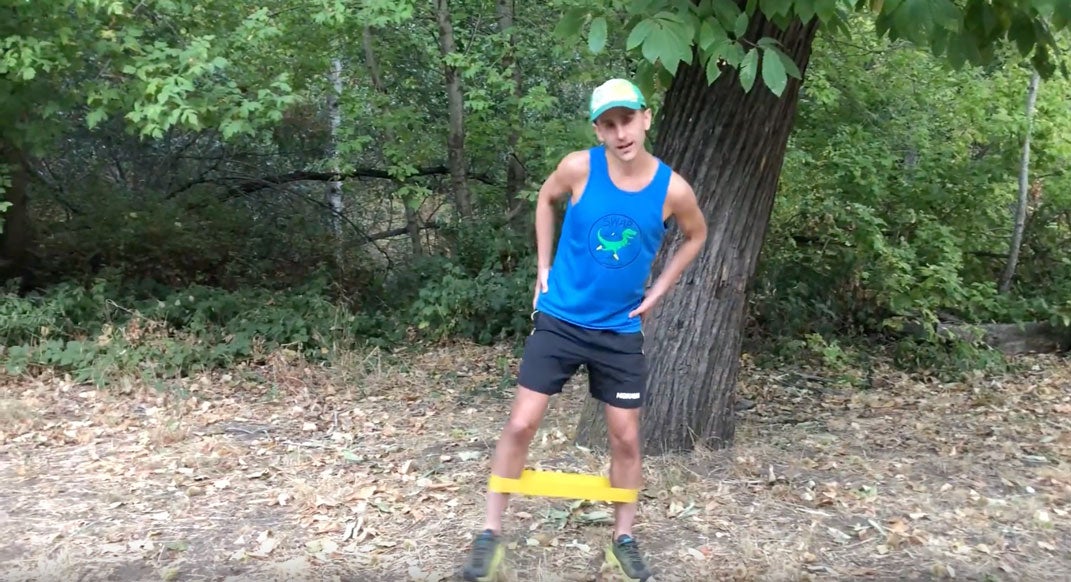A 2-Minute Exercise-Band Routine For Strong Hips

Seven years ago, in the middle of a race, my right hip suddenly lost power. I finished the race, thinking it was nothing.
Narrator: it was not nothing.
That night, I felt a persistent, pounding throb in my groin that meant one of two things: either I was a character in an overwritten romance novel, or I needed to see a doctor. The next week, the doctor reviewed an MRI of my right hip and gasped. The labrum was shredded. Much like romance novel abs.
On the eve of the surgery, I got cold feet and canceled. I doubled down on PT and over the next month, the hip improved. That year was my best running ever, with no hip pain at all. “The body,” a scholar once said, “is a wonderland.”
I have told this story before, so I’ll keep it short. The pain worsened, even with complete rest, and eventually I was scheduled for surgery. On the eve of the surgery, I got cold feet and canceled. I doubled down on PT and over the next month, the hip improved. That year was my best running ever, with no hip pain at all. “The body,” a scholar once said, “is a wonderland.”
Or maybe John Mayer said that. It has to be the PT, right?
PT work works
There are too many variables to isolate, but the main PT work I did involved an exercise band. Over the course of the healing process, the exercise band routine got distilled down to just a couple of minutes. And then, because I’m the worst at this stuff, the routine fell away entirely after a couple years later. You could tell me the secret to everlasting life, and, if it involved strength work, I’d probably be too lazy to be consistent with it.
This summer, my hips started getting janky as crap again. I went to an amazing chiropractor, a wonderful massage therapist. I did lunges, I did squats. I ran in all different types of shoes. It took me months before I remembered the secret of the exercise band. Within a few weeks, I was feeling like Lizzo, “Good As Hell”.
Now that is an excessively long preamble, like one of those internet recipes that goes through a full Kerouac drug trip worth of words before telling you the ingredients to butternut squash soup. But I wanted you to have some background to give context to the two big disclaimers.
RELATED: 8-Minute Speed Legs
Strength Work For Slackers
One, this routine works for me and some of the athletes I coach, but there are better and more thorough routines out there. Essentially, it’s strength and mobility work for people that are not consistent with strength and mobility work. You can use it as a starting point or as an inspiration depending on your background and goals.
Essentially, it’s strength and mobility work for people that are not consistent with strength and mobility work. You can use it as a starting point or as an inspiration depending on your background and goals..
Two, working with a PT is always the best option. Do that. PTs have a wealth of expertise, and they even know what an adductor is.
I like athletes to do this routine before and after running, often with a lighter resistance band before for activation, and a medium band after for strength. It works the hip flexors, stabilizer muscles, high hamstrings, glutes and even the adductors. For me, I feel less sore and more springy after doing the routine consistently. But I am highly, highly susceptible to the placebo effect.
Combine with 3-minute mountain legs, some bodyweight work like push-ups and pull-ups, and some light stretching/rolling (if you’re into that sort of thing), and you have a routine that you can repeat consistently.
Exercise List
Side steps: 10 times in each direction, like you’re a big old crab.
Side steps with eversion: 10 times in direction, like you’re a big old crab crossed with a big old duck.
Monster walk: 20 steps, like you’re a monster with hemorrhoids.
Rearward walk: 10 steps, like you’re a monster with hemorrhoids inefficiently backing that thang up.
Optional hurdle drills: 5 in both directions.
Optional butt strength: 5-10 for both legs.
RELATED: Do-Anywhere Mobility Exercises For Runners
In my personal set-up for athletes, this is how it all fits together:
Warm Up Routine
• Walk around to loosen up
• 2-minute exercise-band routine (light)
• Optional lunge matrix and leg swings
• Optional set of push-ups
• Bounce around/light jogging for 1-2 minutes
• Run
Post-Run Routine
• 2-minute exercise-band routine (moderate, every other day), plus 30 seconds optional band drills (hurdle and butt)
• 3-minute mountain legs 3-5 times per week
• Push-ups and pull-ups … and core work if I’m not a lazy parasite (rare)
• Light stretching (optional) and foam rolling
There are a million things you can do for strength and mobility, just make sure you’re not neglecting it altogether. This quick routine works for me and lots of athletes I coach with similar histories, but you can develop routines that are more complex or research-driven. Or even better, you can work with a professional PT.
Missy Elliott famously said that she don’t want no one-minute man. When it comes to exercise bands, I am two times better than that, so maybe that works.
David Roche partners with runners of all abilities through his coaching service, Some Work, All Play. With Megan Roche, M.D., he hosts the Some Work, All Play podcast on running (and other things), and they wrote a book called The Happy Runner.